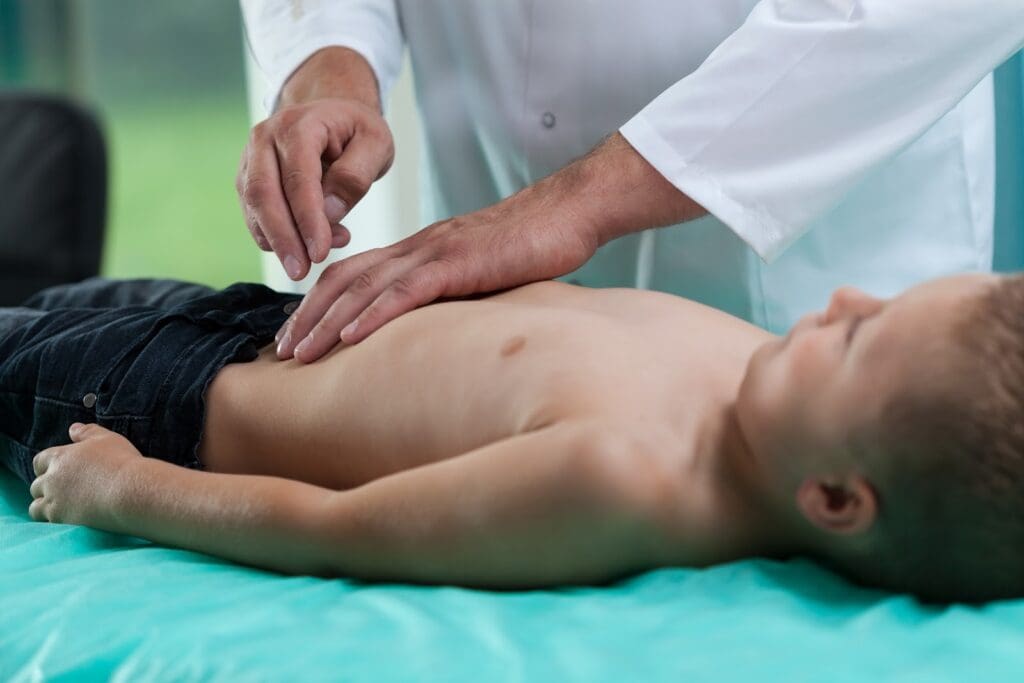Last Updated on November 24, 2025 by
Many parents wonder if their child needs to stay in the hospital for hernia surgery. Or can it be done without an overnight stay? Knowing the answer is key to making the best choice for your child’s health.
Pediatric hernia surgery is often done without needing to stay in the hospital. This is true for most simple cases. Inguinal hernia repair is a common surgery for kids, usually done under general anesthesia.

More and more, kids are having surgery without an overnight stay. This makes the whole process easier and more comfortable for them. We’re here to support you every step of the way.Discover if pediatric inguinal hernia surgery is typically performed as an outpatient procedure. Understand the process.
Knowing about pediatric hernias is important for your child’s health. These hernias are common in kids. It’s key to understand their types and symptoms for quick medical help.
Inguinal hernias in children are usually present from birth. A doctor’s careful check is the best way to diagnose them.

Pediatric hernias are mainly direct and indirect types. Indirect hernias are common in kids. They happen when the abdominal wall has a defect, letting intestines bulge through the inguinal canal. Children rarely get direct hernias, which are a weakening of the abdominal wall.
Spotting an inguinal hernia in newborns and infants is tough. But, there are important signs to watch for. Look for a bulge or swelling in the groin, more so when the child is crying or straining. Prompt medical evaluation is needed if you see these signs.
Keep an eye on your child’s groin area for any changes. If you think they might have an inguinal hernia, see a doctor. Early action is vital for managing the condition and avoiding problems.
Pediatric inguinal hernia surgery is now often done on an outpatient basis. This change is part of a larger effort in healthcare. It aims to cut costs and boost patient happiness without lowering care quality.

Studies show more pediatric inguinal hernia repairs are done on an outpatient basis. For example, about 32.5% of German hospitals do laparoscopic repairs as outpatient procedures. This trend is seen worldwide.
“The move towards outpatient surgery for pediatric inguinal hernias reflects a broader commitment to providing high-quality, patient-centered care,” says a leading pediatric surgeon. “It’s a significant step forward in making healthcare more efficient and less disruptive for families.”
Even with more outpatient hernia repairs, hospitals vary in their methods. This variation depends on the hospital’s size, the presence of pediatric surgical teams, and postoperative care facilities.
Worldwide, there’s a trend towards outpatient management for pediatric inguinal hernias. This is due to better surgical techniques and anesthesia. Liv Hospital is among those following these trends, focusing on safe, high-quality outpatient surgeries.
Outpatient hernia repair has many benefits. It reduces hospital stay, lowers infection risk, and speeds up recovery. Yet, the choice between outpatient and inpatient care depends on the child’s health and needs.
In conclusion, while outpatient pediatric inguinal hernia surgery is becoming more common, it’s vital to keep watching outcomes. This ensures the best care for children with hernia repairs.
Outpatient hernia surgery for kids has many benefits over staying in the hospital. It’s key to know these advantages to choose the best care for your child.
Being at home to recover can be less scary for kids. It lets them feel safe with their family. This psychological comfort helps them heal better and faster.
Outpatient hernia surgery saves money for families and healthcare. It cuts down on hospital costs without sacrificing care quality. For more info, check out the American College of Surgeons on pediatric hernia repair.
Kids get back to their usual activities faster after outpatient surgery. They can recover at home with little pain, thanks to simple meds. This makes their return to normal life quicker.
Other pluses include less chance of getting sick in the hospital, more parent involvement, and care tailored to the child. Knowing these benefits helps families make better choices for their child’s surgery.
Pediatric hernia repair needs careful choice of surgical methods. This balance ensures effective treatment with minimal risk. The technique chosen depends on the child’s age, size, and hernia type.
Open herniorrhaphy is a common method for young children. It involves a small incision in the groin to access the hernia. The hernia sac is then dissected and tied at the internal ring.
This method is often chosen for infants and toddlers. It’s simple and effective. But, like any surgery, it carries risks such as infection and tissue injury.
Laparoscopic hernia repair is used for older children and teens. It’s a minimally invasive method with small incisions. This allows for detailed examination and repair with minimal tissue disruption.
This method is known for quicker recovery and less pain. But, it needs specialized equipment and expertise. The choice depends on the case and surgeon’s experience.
Newborns with hernias need special care due to their small size and fragile tissues. The surgery is precise and performed under general anesthesia. Extra precautions are taken to avoid complications.
Understanding the inguinoscrotal meaning is key for newborn hernia repair. It’s important to know about direct hernia too, as it’s less common in children.
The choice of surgical technique also depends on the child’s age and weight. Laparoscopic repair might be better for older, larger children. Open herniorrhaphy is often chosen for younger or smaller ones.
Each child’s unique needs guide the choice of surgical technique for hernia repair.
When your child has outpatient hernia surgery, knowing what happens is key. It helps you feel more at ease. We want you to know everything about the process to help your child feel comfortable.
Before surgery, we’ll walk you through some steps. These include:
It’s very important to follow our instructions to avoid risks and make the surgery go smoothly.
During the outpatient hernia repair, your child will get general anesthesia. This keeps them comfortable and pain-free. Our experienced team will then do the inguinal hernia surgery. They will use methods that fit your child’s needs.
After surgery, your child will go to a recovery area. Our team will watch them closely. They will check for any problems and manage pain to keep your child comfortable.
Before you take your child home, we check a few things. These include:
When these are all okay, we’ll give you clear instructions on caring for your child at home. This way, you’ll know how to help them recover from pediatric hernia surgery outpatient procedures.
Knowing what to expect at home can make recovery easier for families. After surgery, kids usually heal quickly. But, it’s key to stick to a recovery plan for safe healing.
The recovery time varies with age and health. Infants and younger children often heal faster than older kids. Most can get back to normal in a few days to a week.
Newborns and infants usually bounce back in 2-3 days. Older children might take up to a week to fully recover.
It’s important to limit activities during recovery to avoid problems. Here’s what we suggest:
As kids get more comfortable, they can slowly go back to their usual routine. But, always follow the doctor’s specific instructions.
Even though complications are rare, knowing the warning signs is important. Look out for:
Being informed and watchful helps ensure a smooth recovery from hernia surgery. If you have concerns or questions, always talk to your child’s doctor.
Pediatric inguinal hernias need quick and effective treatment to avoid problems. Knowing the difference between direct and indirect hernias is key. Also, recognizing signs in newborns and infants is important for parents.
Outpatient herniorrhaphy, a surgery to fix hernias, is now common. It offers quick recovery and lower costs. This makes it a good choice for many families.
At Liv Hospital, we follow the latest medical guidelines. This ensures our patients get the best care. For conditions like groin hernia in infants, knowing about herniorrhaphy can ease worries.
Choosing an experienced team is vital. This way, your child gets the right treatment, whether it’s outpatient or inpatient.
Understanding your child’s hernia care options is key. Knowing about the surgery and recovery is important. Being informed helps your child start a healthy and active life.
A pediatric inguinal hernia happens when part of the intestine bulges through a weak spot in the abdominal muscles in the groin. It’s common in kids, mostly in newborns and infants.
Yes, many pediatric hernia surgeries are done on an outpatient basis. This means kids can go home the same day. The decision to do it this way depends on the child’s health, age, and the surgeon’s opinion.
Signs include a bulge or swelling in the groin, pain, and discomfort when coughing or straining. Sometimes, the hernia can be pushed back into the abdomen.
A doctor checks for a bulge in the groin area to diagnose it. They might also use an ultrasound to confirm the diagnosis.
Outpatient surgery is comforting for kids, saves money, and lets them recover faster. It also lowers the risk of infections in hospitals.
Expect preparation before surgery, the procedure itself, and monitoring after. Parents will get instructions on caring for their child, including what activities to avoid and when to seek medical help.
Recovery times vary by age and health. Kids usually can get back to normal in a few days to a week. It’s important to follow the surgeon’s advice and watch for any complications.
Risks include infection, bleeding, and reactions to anesthesia. But serious problems are rare. Talking to a healthcare provider about these risks can help parents make informed choices.
Yes, newborns and infants can have outpatient hernia surgery. But it depends on their health and other factors. Some places have rules for very young children.
Indirect hernias are more common in kids and happen through a natural weakness. Direct hernias are less common and involve a weakening over time. Knowing the type helps decide the best treatment.
Centers for Disease Control and Prevention. (2024). Facts about birth defects. https://www.cdc.gov/ncbddd/birthdefects/facts.html
Hockenberry, M. J., Wilson, D., & Rodgers, C. C. (2019). Wong’s nursing care of infants and children (11th ed.). Mosby. https://www.elsevier.com/books/wongs-nursing-care-of-infants-and-children/hockenberry/978-0-323-54939-5
The Society of American Gastrointestinal and Endoscopic Surgeons (SAGES). (2023). Patient information on hernia repair. https://www.sages.org/publications/patient-information/patient-information-for-hernia-repair-from-sages/
Subscribe to our e-newsletter to stay informed about the latest innovations in the world of health and exclusive offers!